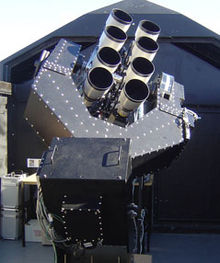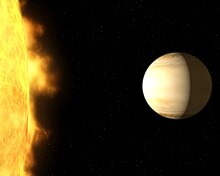SuperWASP
The SuperWASP project is an automatic search engine for extrasolar planets . The European project stands for Super Wide Angle Search for Planets .
Location
SuperWASP consists of two autonomously operating observatories. You are in the Roque de los Muchachos Observatory on La Palma ( 28 ° 45 ′ 36.8 ″ N , 17 ° 52 ′ 45.5 ″ W ) and in the South African Astronomical Observatory , South Africa ( 32 ° 22 ′ 46 ″ S , 20 ° 48 ′ 38 ″ O ).
technology
In specially designed autonomous observatories , eight telephoto lenses (200mm / f1.8 Canon ) are available on horseshoe mounts to carry out around 50,000,000 measurements of star brightness every clear night .
Each lens is connected to an astronomical CCD camera with an area of 2048 × 2048 pixels , which provides an image field of 7.8 × 7.8 degrees .
Measurements
Every night, the cameras are supposed to take around 800 images that are exposed for 35 seconds each .
The brightness of the stars should be determined between 7th and 13th magnitude with 1 percent accuracy (0.01 magnitude classes).
Results
It is hoped that the analysis of the measurements over time will lead to several discoveries of exoplanets that are passing in front of their respective sun and thereby weakening its light . In the meantime, the number of planets newly discovered by the SuperWASP project has risen to over 180 (list in English version).
Discovered exoplanets
see list of extrasolar planets classified as WASP
Similar projects
There are currently around 20 similar projects, e.g. B. OGLE (Optical Gravitational Lensing Experiment), STARE , PSST , HAT , TASS Sky Survey (TASS)
Trivia
WASP 142b is also represented, a planet that the then 15-year-old Tom Wagg discovered during an internship at Keele University. The find was confirmed two years later in 2015.
literature
- SuperWASP: Magnitudes by the Millions , Sky & Telescope, August 2004, p. 30
Web links
Individual evidence
- ↑ Petra Funk: 15-year-old student discovers an unknown planet. In: Ingenieur.de. VDI Verlag GmbH, June 11, 2015, accessed on January 12, 2020 .

